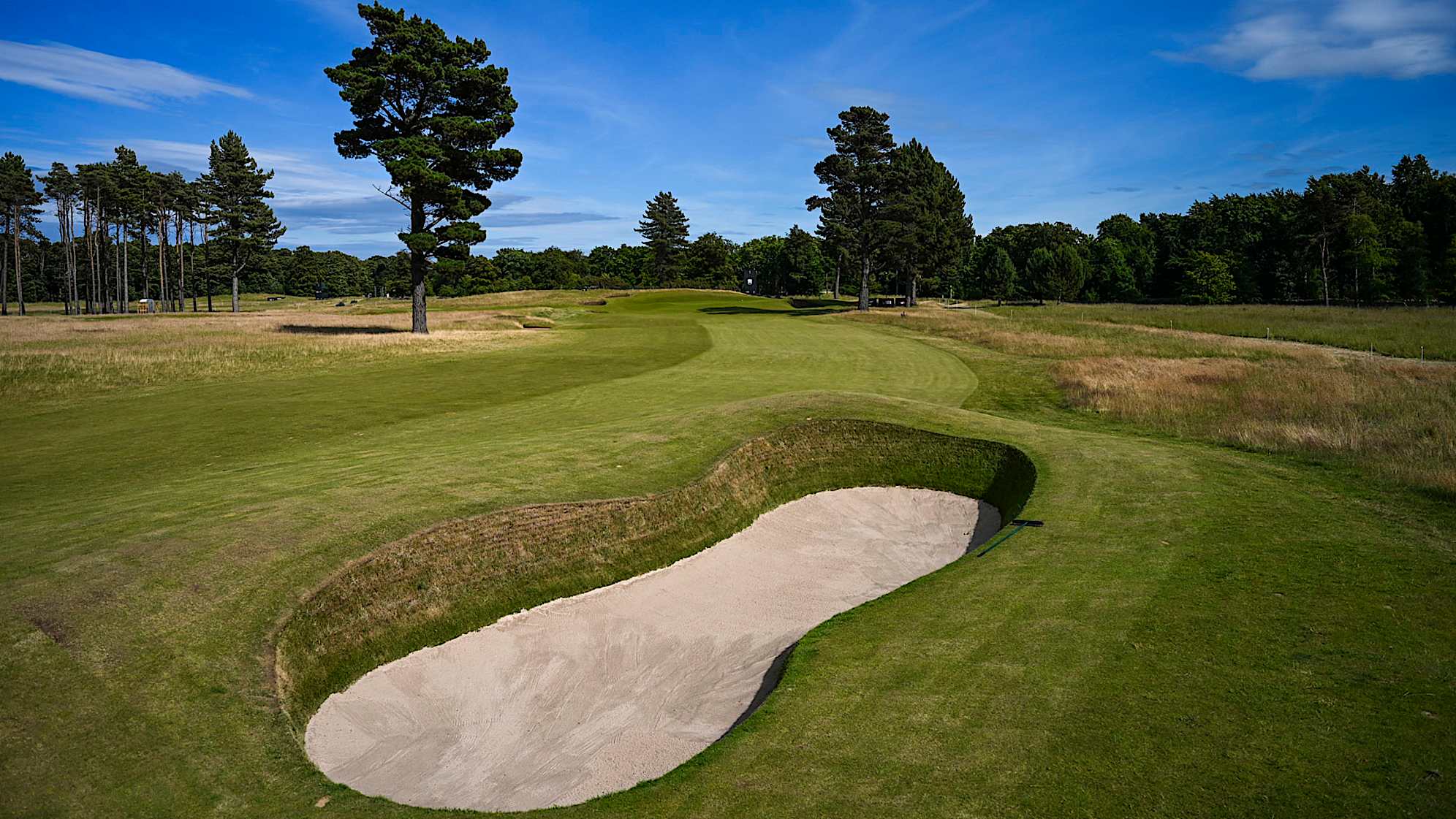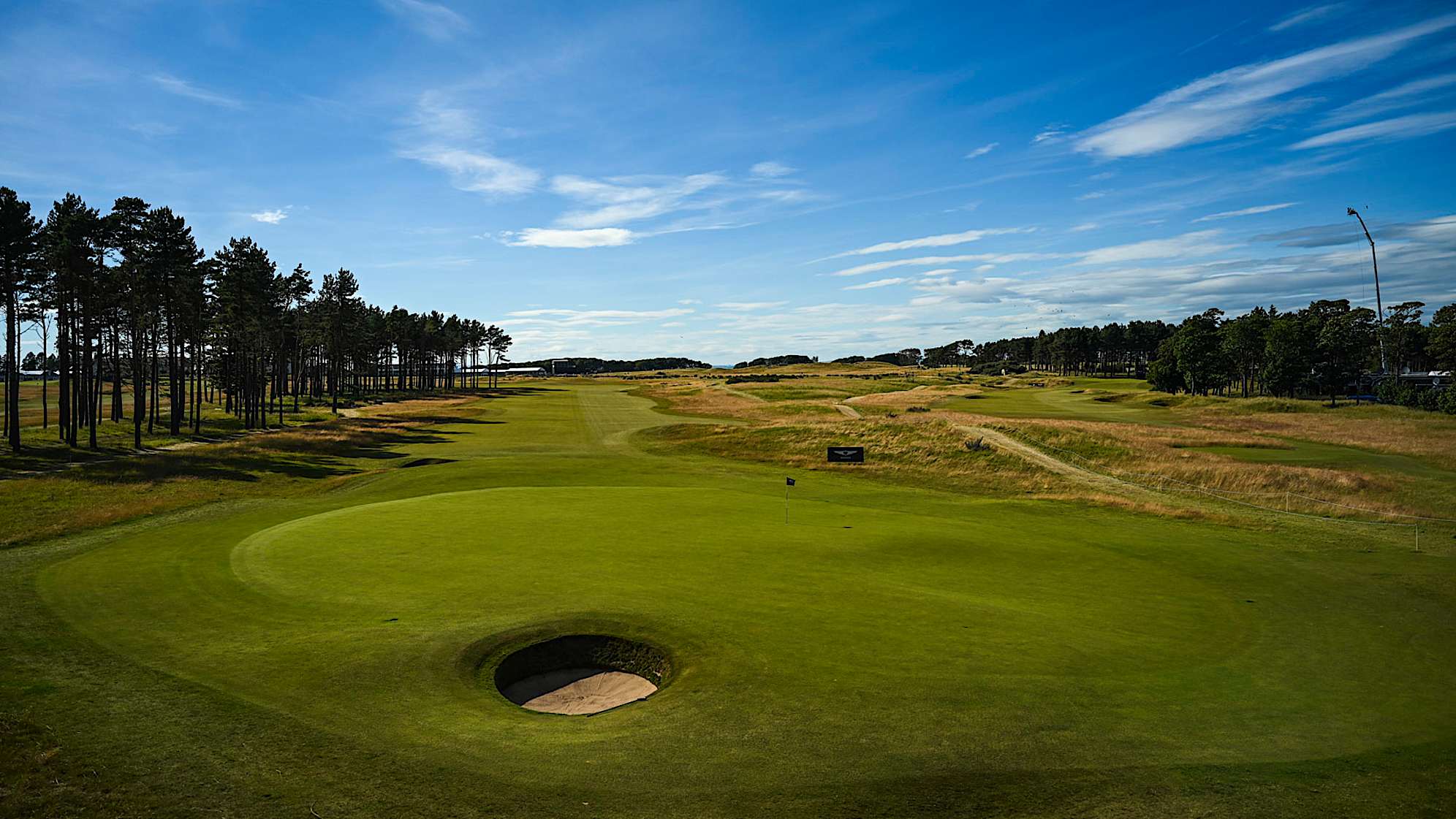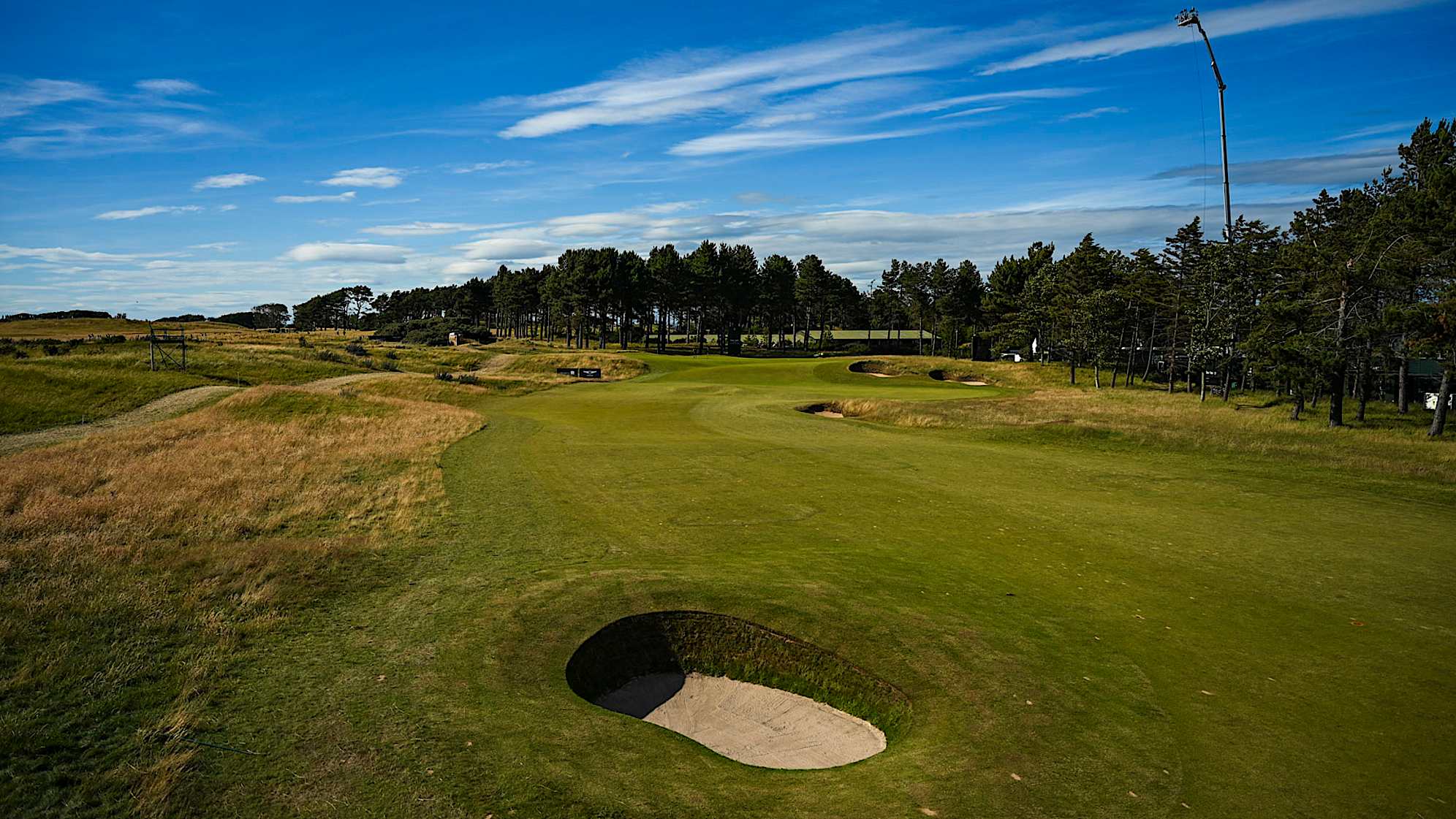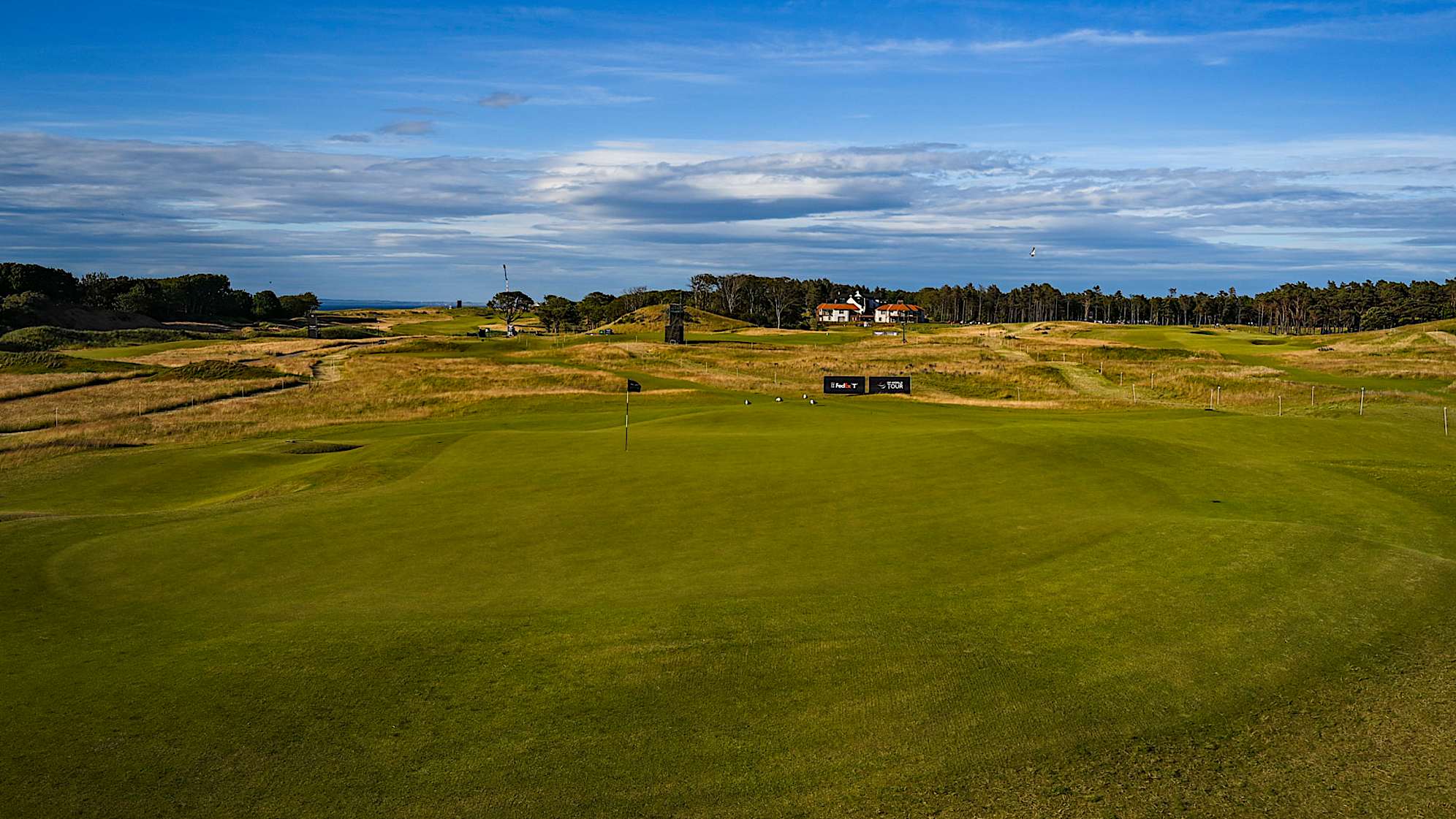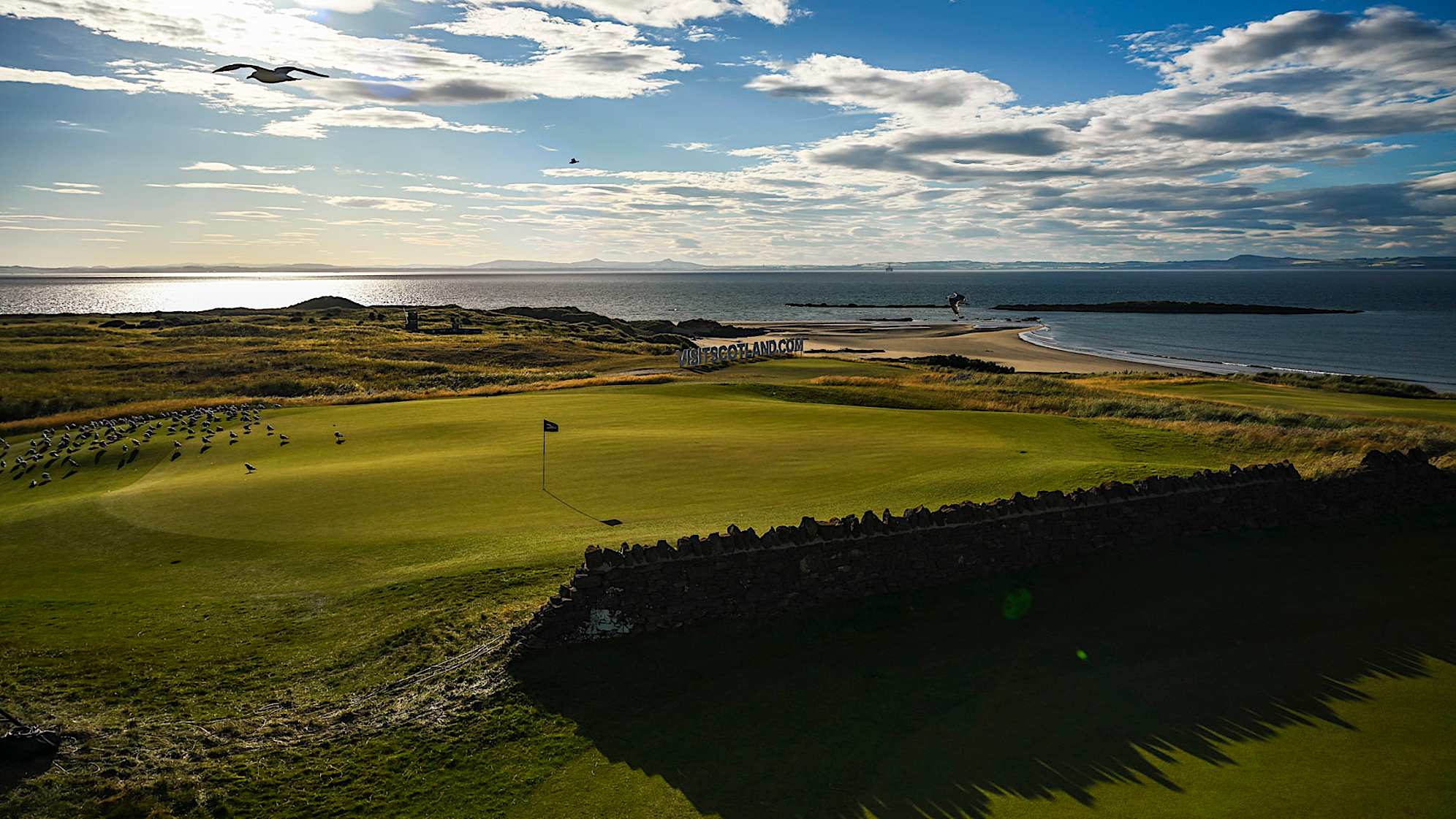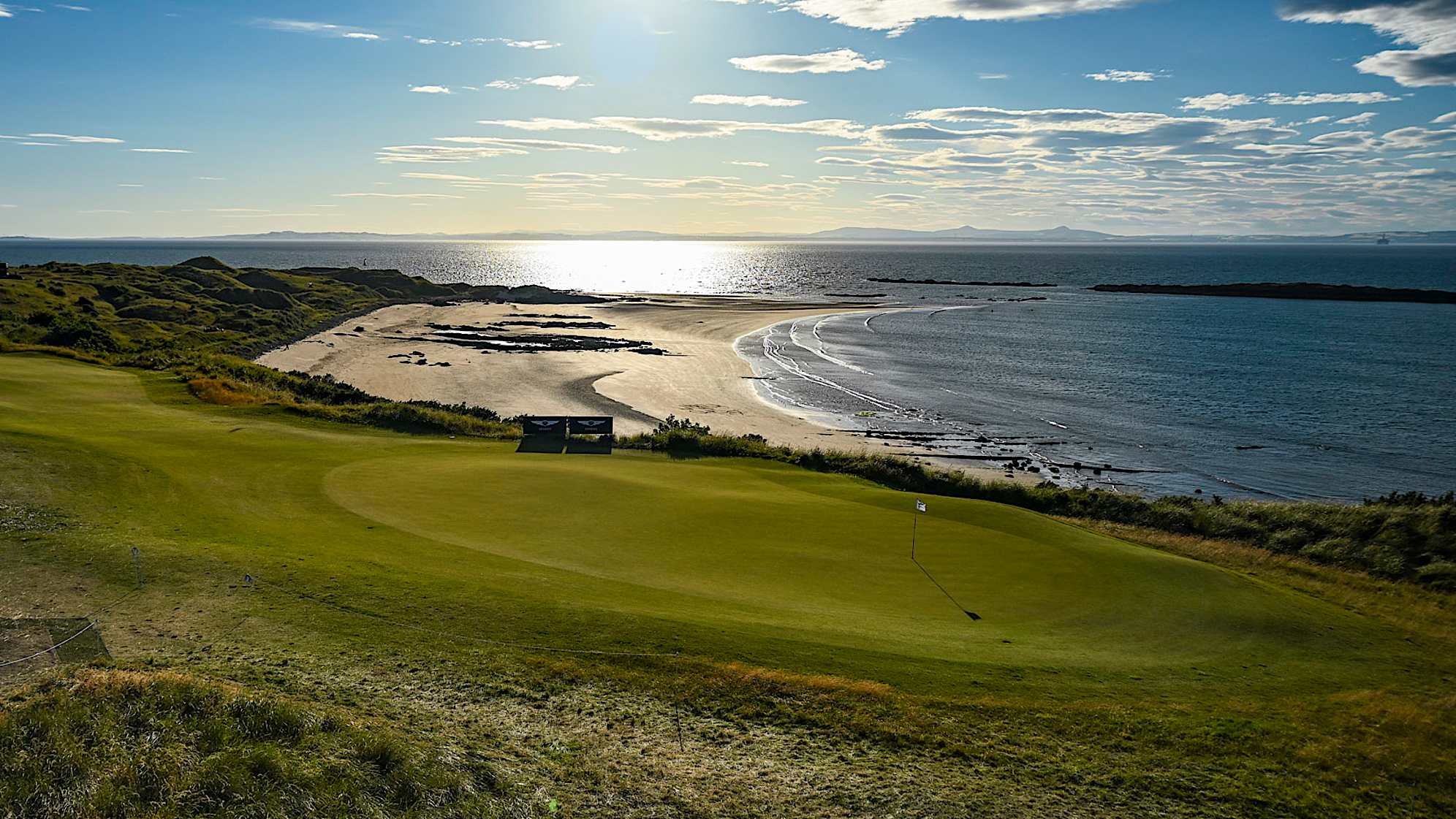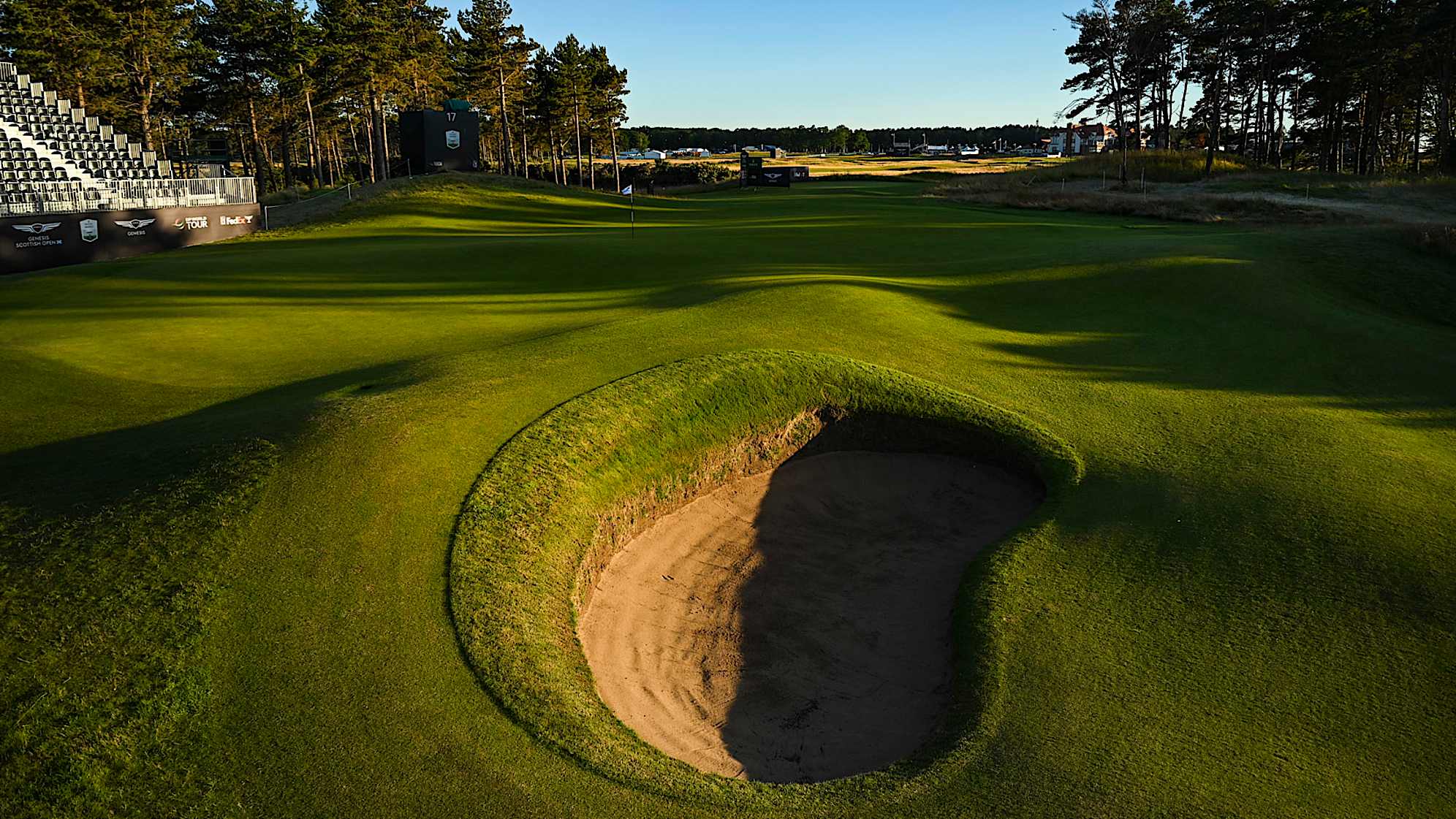Five things to know: The Renaissance Club
9 Min Read

The 18th hole of The Renaissance Club in North Berwick, Scotland. (Keyur Khamar/PGA TOUR)
Written by Jeff Eisenband
This week's Genesis Scottish Open celebrates its 52nd playing and third as a co-sanctioned event between the PGA TOUR and DP World Tour. The national open for the birthplace of the royal and ancient game features six of the world's top eight players, making it one of the summer's strongest fields.
Here are Five Things to Know about The Renaissance Club in North Berwick, host of the Genesis Scottish Open. It was designed by an American but fits in among its historic neighbors in the golf-rich East Lothian region of Scotland.
1. Modern look, historic setting
In 1744, the Honourable Company of Edinburgh Golfers established 13 rules for the game of golf. That was three decades before the United States declared independence from Great Britain. The Honourable Company found a permanent home at Muirfield in 1891. Muirfield, which remains part of The Open rota, borders The Renaissance Club, which is a modern venue in this historic setting.
It was not a group of 18th-century Scotsmen who founded The Renaissance Club, but instead a group of Americans in the 20th century. The Sarvadi family was in Pinehurst, North Carolina, two decades ago when an associate asked if they’d be interested in building a course in Scotland. That associate was Don Lewis, whose father-in-law, Pandel Savic, was one of the co-founders of Jack Nicklaus’ Muirfield Village (a course that Nicklaus named after Scotland’s Muirfield, the setting of his first triumph in The Open).
Jerry Sarvadi, who made his fortune in aviation fuel, took the lead among the nine siblings. He was invited to play Muirfield shortly before the 2002 Open Championship and loved what he saw in the neighboring property. He met with trustees from the proposed site of the new course, which was owned by the Duke of Hamilton, and after multiple trips to Scotland, signed a 99-year lease in 2005.
The Sarvadis added another American to the fold, hiring Tom Doak to design the course. Doak hails from Michigan but has plenty of experience working with the firm seaside turf that’s best suited for links courses, most notably at Oregon’s Bandon Dunes Resort, where he built Pacific Dunes. That course, ranked 18th in Golf Digest’s list of top courses in the United States, opened in 2001. Doak, one of today’s most prominent architects, is known for using short grass, dramatic slopes and firm conditions to create a challenge, much like Augusta National’s architect, Alister Mackenzie, about whom Doak wrote a book. Doak’s other top 100 designs include Sebonack Golf Club in New York, Colorado’s Ballyneal, the Old Macdonald course at Bandon Dunes and Montana’s Rock Creek Cattle Company.
“Our intent was always to create a course that feels like it belongs on that site and on the coast of East Lothian,” said Doak, a scholar of global golf architecture who spent his first year out of college caddying at St. Andrews and studying the great courses of the U.K., just as his mentor, Pete Dye, had done.
The result at The Renaissance Club is not an American-influenced course in Scotland, but a tribute to Scottish golf that was created by Americans.
2. The Muirfield trade
While trees are mostly absent from Scottish courses, The Renaissance Club was built on a site that featured 300 acres of pine trees and needed 8,500 tons of wood cleared. According to Sarvadi, the property’s unusual treeline was the result of Britain’s Forestry Commission planting large stands of pine and sycamore after World War II. When the team from The Renaissance Club pulled out tree stumps, they found pure sand beneath the trees.
Upon opening, Sarvadi and Doak kept a chunk of trees on the property. These well-placed pines exert their influence on some tee shots and approach shots. Many of them were still present when the Genesis Scottish Open arrived in 2019, but a batch of trees were stripped from the land before the 2020 event, altering the aesthetics of the track.
The trees proved to be an important trade asset for The Renaissance Club, as they also served to shroud neighboring Muirfield.
“Muirfield owned all the dunes to the north of the course,” Doak recalls. “But The Renaissance Club owned the woods right up to the wall at the eighth green of Muirfield, so to protect that boundary … the (Honourable Company of Edinburgh Golfers) offered to trade a bit of their land in the dunes, which we happily accepted.”
Doak told The Fried Egg podcast in 2021 that “for all Muirfield knew, we’d knock down all the trees and build a hole right there and wave at the members of Muirfield.” Doak says Sarvadi and the team never planned on doing this, but the leverage was useful.
Along with establishing a defined buffer, Muirfield used some of its acquired land to move around the ninth tee box during the 2013 Open Championship. Meanwhile, The Renaissance Club applied to extend its course into the newly-acquired dunes, a process that took approximately five years. When given the green light, Doak was brought back in to make three new holes directly on the coast. Those holes are Nos. 9, 10 and 11 on a normal day and Nos. 12, 13 and 14 for the Genesis Scottish Open.
3. Path to the coast
Starting with the 10th hole, a short par 5 that is the seventh hole for everyday play, viewers this week will watch as the course marches out toward the Firth of Forth. The next hole is a long par 4 that can be stretched to 510 yards and sometimes plays into the wind. Then comes The Renaissance Club’s signature stretch along the dunes.
“The prettiest view on the course is when you walk up onto the 12th and the lighthouse on Fidra (an uninhabited island in the Firth of Forth) comes into view after you couldn’t quite see it from the tee,” Doak said. “Then the next hole plays right along cliffs with a secluded beach to the left. And then at the 14th, you turn around and play back toward Arthur’s Seat (an ancient volcano) in Edinburgh around the curve of the shoreline.”
Nos. 12 and 14 for the Genesis Scottish Open are par 3s, while No. 13 is par 4. It’s a beautiful stretch for players making the turn on a normal day, but the routing is altered for the Genesis Scottish Open to avoid shuttling players to the far side of the course for a 10th-tee start. The tournament uses the regular routing’s first six holes before closing out the front nine with what the members play as Nos. 16, 14 and 15. The tournament’s back nine starts on the members’ seventh hole. Nos. 7-13 are the opening of the back nine for the Genesis Scottish Open before the layout concludes with the same two holes that the members finish on.
This routing may lead to some longer walks between holes, but it does keep half the field from starting with the treacherous tee shot along the cliffs on No. 13 (No. 10 on the normal layout).
4. Harrington's help
While The Renaissance Club has a uniquely American history for a Scottish course, it recently enlisted a links legend to improve it for tournament play. Padraig Harrington, who has twice hoisted the Claret Jug, was brought on as a player consultant shortly before the 2021 Genesis Scottish Open.
“From the beginning, the goal for The Renaissance Club was to host big events, but that was back in 2005, and the best players just keep getting better,” Doak said at the time.
Harrington, who also served as the European captain at the last Ryder Cup, noted that his job would be to both pass along his ideas to Doak while also gathering feedback from the top professionals in the world.
“Padraig has been great, both as a sounding board for my ideas on changes and as a source of ideas himself,” Doak said. “I was always taught not to take the driver out of players’ hands, but it’s a new era, and he has underscored that we needed to tighten the landing areas of the longer holes or the game is too easy for these guys. Sometimes it’s an added bunker (to the right of the first) and sometimes just some added contour so they’ll have to hit from an awkward lie if they bail away to the safe side of the fairway. Most of all, though, Padraig has been steady in saying the course is a good test and we don’t want to overreact to the low scores just as players are starting to come around to it.”
The winning score in the five Genesis Scottish Opens at The Renaissance Club has been 22, 11, 18, 7 and 15 under par. Soft and calm conditions are a big reason for that, although the 2022 event (won by Xander Schauffele at 7 under) required a consistent battle with Mother Nature. The final-round conditions in 2023 also posed a stern test, epitomized by Rory McIlroy's stinging 2-iron below the wind on the 72nd hole to set up a winning birdie.
“In particular, we are looking to strengthen the par-5 holes, where a lot of the red numbers come from,” Doak said. “But we have been going slowly with changes because the truth is that over 12 rounds, the pros have yet to see the course with firm conditions and the normally strong winds from the west. You have to design a links course to be playable in strong winds, but if it rains just before the tournament every year, they’re going to keep shooting low scores.”
5. Whims of the wind
When there's a lack of wind at The Renaissance Club, low scores will follow. Courses built along the Scottish coast have to be designed with the wind in mind, but Genesis Scottish Open competitors haven't always seen the course in the most difficult conditions. That has gradually changed in the past two years, with Schauffele's grind to a 7-under winning score in 2022 and McIlroy's gritty closing stretch in 2023 to outlast local hero Robert MacIntyre by a stroke.
“It’s designed around windy conditions and so far, the Scottish Open weeks have been unusually calm, apart from one very nasty round in 2020,” Doak said in 2021. It’s also worth noting that the 2020 Genesis Scottish Open was played in October because of the COVID-19 pandemic.
If the wind hits this week, The Renaissance Club should play to its full challenging potential, of which there have been glimpses in the past two playings.
“The windier and firmer it is, the more ball-striking plays a premium,” Doak said. “If it’s soft, it becomes more of a putting contest, and that’s not what the best players want to see. There are a few greens with some really tricky short-game shots – the back pin on the 18th is one, but more of them are on the front nine, as well as the shots around the 10th and 11th greens.”

